
The effects of aging on canine vision share several similarities with those experienced by humans, leading to a decline in eyesight quality as dogs grow older. The following is an overview of how age impacts a dog’s eyesight:
Middle Age Effects
1. Presbyopia

Just like humans, dogs can experience presbyopia in middle age. The lens of their eyes becomes less flexible, making it difficult to focus on nearby objects and it is a natural part of the aging process.
Dogs with presbyopia may show signs of decreased ability to see objects up close. However, since dogs rely more on their sense of smell and hearing than on vision, they may not show obvious signs of vision problems.
Old Age Changes

1. Lens Changes
Yellowing/Browning
Long-term exposure to ultraviolet light, wind, and dust can cause the lens to yellow or brown.
Nuclear Sclerosis
Dogs often develop a bluish haze in their eyes due to the increased density and transparency of the lens. This condition is known as nuclear sclerosis and is a normal part of aging that usually doesn’t affect vision significantly.
2. Conjunctiva and Tear Production
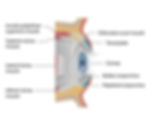
Thinning of the Conjunctiva
The conjunctiva, a membrane covering the white part of the eye, can thin with age.
Decreased Tear Production
Older dogs often produce fewer tears, leading to dry eyes. Dry eyes can cause discomfort and increase the risk of eye infections.
3. Corneal Changes
Arcus Senilis
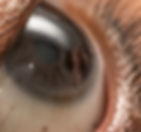
This condition, a ring of cholesterol deposits around the cornea, is common in aging dogs but doesn’t typically affect vision. In dogs, it is also characterized by a white, gray, or bluish ring around the outer edge of the cornea, typically associated with aging and is generally considered a normal part of the aging process. While arcus senilis in dogs is typically harmless and not usually linked to systemic health issues, it can sometimes indicate high cholesterol or other lipid abnormalities.
4. Retinal Diseases
Macular Degeneration
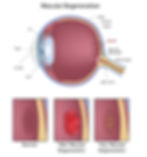
Similar to humans, dogs can suffer from age-related macular degeneration, leading to loss of central vision. Macular degeneration is a medical condition that primarily affects the central part of the retina, known as the macula. In dogs, the macula plays a crucial role in their vision, much like in humans, although there are some differences. The macula is a part of the retina, responsible for detailed central vision and color perception. The role of the macula in dogs includes:-
1. Central Vision: The macula in dogs contributes to their central vision, allowing them to see objects directly in front of them with greater clarity.
2. Colour Perception: While dogs do have colour vision, it is more limited compared to humans. Dogs are dichromatic, meaning they primarily see shades of blue and yellow. Their macula helps process these colours, but they cannot distinguish between red and green.
3. Detail and Motion Detection: The macula in dogs aids in detecting details and motion in their environment. This is crucial for hunting and navigating their surroundings.
There are two types of macula degeneration, i.e., dry macula and wet macula degenerations.
1. Dry Macular Degeneration
This is the most common form (about 80-90% of cases) and occurs when the macula thins with age and gradually loses function. It is characterized by the presence of drusen, which are tiny yellow or white deposits under the retina. It progresses slowly and may result in mild to moderate vision loss.
2. Wet Macular Degeneration
This type is less common but more severe and occurs when abnormal blood vessels grow under the retina and macula, leading to leakage of blood and fluid. This causes rapid and severe vision loss if untreated.
Retinal Detachment
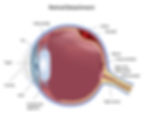
Retinal detachment in dogs is a serious condition where the retina, the light-sensitive layer at the back of the eye, separates from its underlying supportive tissue. This can lead to partial or complete vision loss if not treated promptly. This serious condition can occur in older dogs, leading to sudden vision loss.
Progressive Retinal Atrophy (PRA)
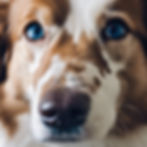
Progressive Retinal Atrophy (PRA) in dogs is a group of common inherited eye disorders that lead to the gradual deterioration of the retina, ultimately causing blindness. It affects both rods and cones in the retina, leading to a progressive loss of vision. There are two main types of PRA:
Generalized PRA (GPRA): This is the most common form and affects the entire retina.
Central PRA (CPRA): This form primarily affects the central part of the retina.
PRA is a genetic condition inherited from the parents. It is seen in many dog breeds, with certain breeds being more predisposed, such as Poodles, Labradors, Cocker Spaniels, and Dachshunds.
Dogs with PRA often first show signs of poor vision in low light or at night, as the rod cells (responsible for night vision) deteriorate first. As the condition progresses, dogs begin to lose vision during the day as well, due to the degeneration of cone cells (responsible for daylight and color vision). The pupils may appear larger than normal and may not constrict properly in response to light or the dogs may become more sensitive to bright lights.
5. Cataracts

Cataracts in dogs are a common eye condition characterized by clouding of the lens inside the eye, leading to impaired vision and are common in older dogs. The causes include: -
Genetics: Many cataracts in dogs are hereditary and can affect specific breeds more commonly.
Aging: Like humans, dogs can develop cataracts as they age, typically appearing in senior dogs.
Diabetes: Diabetic dogs are at a higher risk for developing cataracts, often rapidly.
Trauma: Injuries to the eye can lead to cataract formation.
Inflammation: Conditions like uveitis (inflammation of the eye's uvea) can result in cataracts.
Toxins and Nutritional Deficiencies: Exposure to certain toxins or deficiencies in essential nutrients during development can also cause cataracts.
6. Eyelid and Orbital Changes
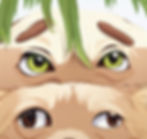
Ectropion and Entropion
Age-related loosening of the eyelids can cause the lower eyelid to turn outward (ectropion) or inward (entropion), causing discomfort and potential damage to the eye.
Ptosis
Drooping of the upper eyelid due to weakened muscles.
Enophthalmos
Shrinking of the fat around the orbit can cause the eyeball to sink backward, leading to a sunken appearance.
Orbital Fat Protrusion
Lax tissues can cause orbital fat to bulge forward, making the eyelids look puffy.
7. Pupil Changes

Decreased Pupil Size
The muscles controlling the pupils weaken, causing smaller and slower-reacting pupils.
Difficulties with Light
Older dogs may struggle with adjusting to different light conditions, finding it harder to see in dim light or being dazzled by bright light.
8. Visual Acuity
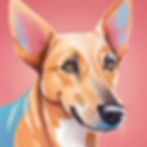
Reduced Sharpness
Vision sharpness decreases with age, even with the best corrective measures. This is especially true for dogs with cataracts or retinal diseases.
Increased Need for Light
Older dogs require brighter illumination and greater contrast to see clearly.
9. Floaters
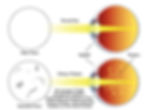
Similar to humans, dogs may see increased numbers of floaters (black spots) in their vision, which typically do not interfere significantly with sight.
Managing Aging Vision in Dogs
Regular Vet Check-Ups
Routine eye exams can help detect and manage age-related eye conditions early.
Adequate Lighting
Ensure environments are well-lit to help older dogs navigate more easily.
Moisturizing Eye Drops
For dogs with dry eyes, vet-recommended eye drops can provide relief and prevent complications.
Diet and Supplements
Proper nutrition and supplements can support eye health.
Surgery
Conditions like cataracts may be treated surgically to restore vision.
Understanding these changes can help pet owners provide better care and improve the quality of life for their aging canine companions.
References
Gelatt, K. N. (Ed.). (2013). Veterinary Ophthalmology (5th ed.). John Wiley & Sons.
Gelatt, K. N., & Gelatt, J. P. (Eds.). (2011). Veterinary Ophthalmic Surgery. Saunders Elsevier.
Williams, D. L. (2008). Ocular disease in older dogs. Journal of Veterinary Internal Medicine, 22(3), 628-635.
Nadelstein, B., & Dubielzig, R. R. (2016). Age-related ocular changes in dogs. Veterinary Clinics of North America: Small Animal Practice, 46(6), 1137-1149.
Parshall, C. J., & Aguirre, G. D. (2011). Progressive retinal atrophy in dogs. Veterinary Clinics of North America: Small Animal Practice, 41(6), 1203-1223.
Whitley, R. D., & Gilger, B. C. (1999). Ophthalmic diseases in veterinary medicine. American Journal of Veterinary Research, 60(7), 907-914.
